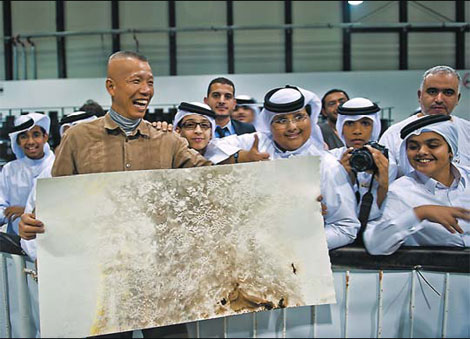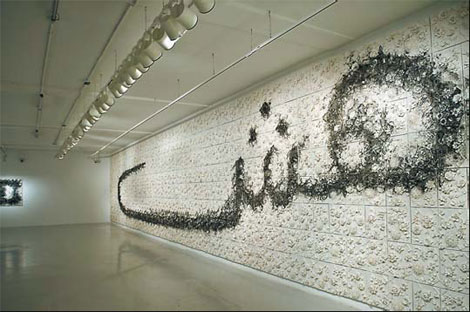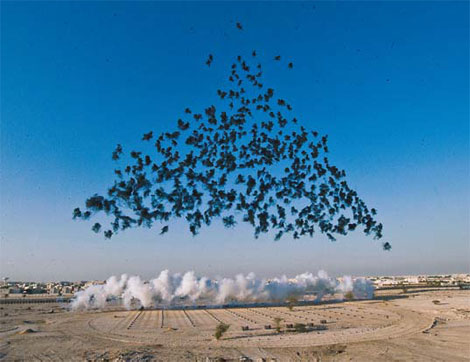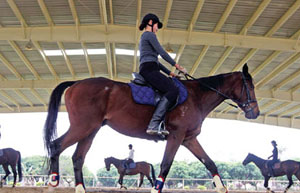Beginning with a bang!
Updated: 2011-12-20 08:05
By Mu Qian (China Daily)
|
|||||||||
|
Fireballs are created with petroleum in Black Ceremony, the opening of Cai Guoqiang's solo show in Doha. Photos by Lin Yi / For China Daily |
|
Cai stayed in Doha for 50 days to learn more about Arab culture before his show. |
|
Fragile is a combination of porcelain and gunpowder. |
|
A pyramid appears during Cai's explosive artwork. |
A huge explosive artwork preceded the opening of Cai Guoqiang: Saraab at the Mathaf: Arab Museum of Modern Art in Doha. Mu Qian was there to witness the opening of the exhibition.
After a series of thunderous sounds, a huge black circle appears in the sky, shaped like the coil of an Arab man's headdress.
The spectators scream as 10 scenes explode inside 10 minutes, ranging from a rainbow to a fireball. Appearing like a constellation of signal shells and at other times like a watercolor painting, the fireworks play out above a stretch of open land on the outskirts of Doha, Qatar.
Nearby is the Mathaf: Arab Museum of Modern Art, where the exhibition opening of Cai Guoqiang: Saraab is preceded by the explosive display Black Ceremony.
"This is the first time that I have seen explosions adopted as an art form, and I really enjoyed it. I'm glad to have this kind of art here in Qatar," says Shareefa Hussain Darwish, a sophomore student of interior design from the Virginia Commonwealth University in Qatar.
Like many others in Doha, Darwish was not familiar with the name Cai Guoqiang (Cai Guo-Qiang) until recently, when advertisements of his exhibition began to appear across the city on everything, from carts in the airport to shopping malls.
The Chinese artist's name also spread by word of mouth, as he had stayed in the city for 50 days before the exhibition, working with local volunteers on works displayed at Saraab (Mirage), Cai's first solo exhibition in the Middle East and the first single-artist exhibition presented by Mathaf: Arab Museum of Modern Art, which was founded a year ago.
"This is the longest time that I have stayed in a country for an exhibition," says Cai, who has lived in New York since 1995. "It was not only due to the long process it took to produce some of the works, but also because I felt I should live here and humbly learn more about Arab culture."
Cai, who is perhaps best known for his celebratory firework project Footprints of History at the Opening Ceremony of the Beijing Olympic Games, chose to use a palette of mainly black colors for his firework event.
"The Black Ceremony was a funeral march for those Arabs who traveled to China more than 1,000 years ago and never returned," he explains.
Before attendees enter Mathaf, they walk among an installation work, made of 62 boulders, that winds its way from outside the museum into the atrium. Engraved with scripts from the Quran and Muhammad's sayings, the stones shipped from Cai's hometown of Quanzhou, Fujian province, form the installation Homecoming, one of the most important works created for the exhibition.
Cai discovered these scripts on the many Arab tombstones in Quanzhou, which was one of the first Chinese cities where Arab traders landed, during the Tang Dynasty (AD 618-907).
"When I see the scripts on these rocks from China, there's a whole different meaning to them," says Wassan Al-Khudhairi, director of Mathaf and curator of the exhibition. "What Cai does with this work is pay homage to those Arabs who traveled to and died in China."
A number of other works at the exhibition deal with the relationship between the Arab world and China in ancient times.
The installation Endless creates a corner of the ocean in a gallery cast in artificial fog, where two Qatari houri boats and a traditional Chinese fishing boat rock gently in the water. Their continuous swaying seems to suggest simultaneously the possibility of travel and being at rest.
Route consists of a gunpowder drawing lying horizontal across a rocky surface, resembling desert plains. In the style of a woodblock print, the artist uses gunpowder to create a modern map in the format of old nautical charts.
Fragile, a 3-meter high by 18-meter long porcelain mural of 480 individual panels, is a combination of porcelain and gunpowder. The porcelain was manufactured near Quanzhou and was historically traded by sea to the Arab world.
"The new commissions reflect my relationship with Arab culture and draw from the relationship between the Middle East and the world, as well as my sentiments and confusions toward the Arab world," Cai says.
Showcasing more than 50 works, including 17 newly commissioned works, Saraab is Cai's largest exhibition of new works after his retrospective at the Guggenheim in 2008. The works include installations, videos, gunpowder drawings and oil paintings. The exhibition also features a documentary about the making of the commissioned works.
On the museum's upper floor, Cai's past works form a mini retrospective that illustrates his growth as an artist.
"This is the first time we have turned our eyes eastward, to consider the dynamics of cultural exchanges between our region and China," Al-Khudhairi says. "By re-imagining Asian connections in this way, Saraab can help viewers look beyond an East-West relationship in contemporary art."
For his first solo exhibition in the Middle East, Cai says he has paid much attention to the area's cultural environment. For example, he has avoided the use of nudity in his works, unlike his exhibitions in the West.
At the same time, he still wants his exhibition to further stimulate the Arab world, where contemporary art is largely limited to painting.
"Through the collaboration and exchanges with volunteers in making gunpowder drawings and by opening the creative process to the public, I had the chance to work with young artists, and discuss how to transform traditional mediums and cultural symbols into contemporary concepts and art forms," he says.
Some symbols used in Cai's works have induced different interpretations. For instance, a local TV reporter asked Cai whether Flying Together - an installation showing a lifelike camel held in the beaks of a group of falcons - insinuates that oil resources in the Middle East (represented by the camel) are being divided and swallowed by world powers (symbolized by the falcons).
The scene of a fireball created with petroleum in Black Ceremony was also divined by some to refer to terrorist attacks.
While affirming viewers' rights to interpret his works based on their own understandings, Cai shuns a direct relationship to reality and says he does not act like a news commentator when he works as an artist.
Rather, he says, the camel and falcon represent two sides of the spiritual character of Arab people, while Black Ceremony is "one of the biggest explosion events in the world, created for the purpose of art".
"China is complicated enough as it is, and including the Arab world in the mix only adds to the confusion," Cai writes in the exhibition's brochure notes.
Saraab is on view at Mathaf: Arab Museum of Modern Art in Doha until May 26, 2012.















